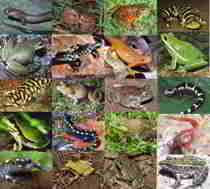
South Carolina Symbols
South Carolina State Amphibian
Spotted Salamander

(Ambystoma maculatum)
Adopted on June 11, 1999.
The 1997-98 third-grade class of Lynn K. Burgess at Woodlands Heights Elementary School, Spartanburg, took notice of the fact that South Carolina has never adopted and does not have an official state amphibian; and the Spotted Salamander, (Ambystoma maculatum,) which is the only amphibian indigenous to the whole State, survives by avoiding bottomlands subject to regular flooding and permanent ponds containing fish, and is the only amphibian that is recommended by Lynn K. Burgess's 1997-98 third-grade class.The Spotted Salamander, (Ambystoma maculatum,) was designated as the official State Amphibian by Act No. 79, 1999, adopted on June 11, 1999.
South Carolina State Amphibian:
Spotted Salamander

A. maculatum males are generally black with two rows of large yellow to yellowish orange spots on their heads, backs, and tails. The spots may vary in number from 24 to 45. Unspotted individuals do occur but are rare. Spotted salamanders are fairly large, usually 5-7 inches long, but some may be over 9 inches long. The adults feed primarily on invertebrates such as earthworms, insects, and mollusks. Aquatic larvae generally eat small animals such as zooplankton and insect larvae that live in the same pond, but sometimes salamander larvae are cannibals, and they eat other salamanders! Spotted salamanders are common in bottomland forests near floodplains, but also occur in upland forests and in mountainous regions. Like other closely related species of mole salamanders, spotted salamanders spend most of their lives on land and migrate to ponds for breeding. They survive best in ponds that do not contain fish, which will eat larvae.
Food Habits
The spotted salamander uses its sticky tongue to catch food. Their diet consists mainly of worms, insects, and underground snails. The salamanders are also important predators on dipteran larvae, which are found in the temporary pools these salamanders' depend upon for breeding. Salamander larvae are also carnivorous. They feed on daphnia and similar sized creatures. In times of overcrowding, usually when the vernal pools start to dry up, spotted larvae are cannibalistic on their own species.
Reproduction
Adult salamanders migrate to wetland breeding sites on rainy nights in the winter, and may remain at the site for only 3 days before returning to their terrestrial habitats. Fertilization is internal by means of spermatophores. The females lay compact egg masses that are attached to submerged objects. The egg mass is covered with thick, milky-white jelly. The average number of eggs in a mass is 125. After 4-7 weeks the eggs hatch into dull olive green, aquatic larvae without spots; 2-4 months later larvae metamorphose and leave the pond in search of terrestrial habitats. The larvae look similar to tadpoles upon hatching because they have feathery gills and no hind legs. The larvae go through a period of 61-110 days of development. Transforming larvae can be found during the months of August and September. The yellow and orange spots are usually acquired within a week following transformation. Some spotted salamanders may live more than 30 years, returning to the same pond to breed every year.
Behavior
A majority of the spotted salamanders' behavior is exhibited during breeding periods. Immigrating spotted salamander females weigh more than the
males when reaching the breeding pool. During breeding the females undergo a three-fold reduction in mass. This loss is equal to the mass of gametes.
This loss leaves females weak and susceptible to death, which contributes to the small number of females to males (Sexton, 1986). With males outnumbering
the females the males exhibit male to male competition for mates. To maximize their chances of reproductive success, individual males produce up to
80 spermatophores. One method exhibited to increase reproductive success is the males capping rival males spermatophores with their own. The spermatophore
on top will be picked up by the females cloaca, while the spermatophore on the bottom is left behind.
To arrive at the breeding ponds, males and females enter and exit the water by using specific paths. These paths are usually associated with valleys,
which funnel the salamanders' into the pond and cut down on travel time.
Habitat
Spotted salamanders are rarely seen due to their habit of staying underground. These salamanders are 'mole salamanders' and require areas with suitable soil for burrowing. Adult spotted salamanders are most abundant in areas of deciduous and mixed forests. The habitat provides the salamanders with existing burrows and coverage under logs and rocks. During breeding season the forest provides vernal pools and ditches necessary for reproduction. The spotted salamander selects temporary water bodies with moderate pH (3.9) for breeding.
South Carolina General Assembly Bill No. 3111
On June 6, 1999 House Bill No. 3111 was approved by the South Carolina Legislature. On June 11, 1999, the legislation was signed by Governor Beasley making the Spotted Salamander the official state amphibian of South Carolina.
(A79, R147, H3111)
AN ACT TO AMEND THE CODE OF LAWS OF SOUTH CAROLINA, 1976, BY ADDING SECTION 1-1-699 SO AS TO DESIGNATE THE SPOTTED SALAMANDER, AMBYSTOMA MACULATUM,
AS THE OFFICIAL STATE AMPHIBIAN.
Whereas, incident to being introduced to the history of the State of South Carolina, the 1997-98 third-grade class of Lynn K. Burgess at Woodlands
Heights Elementary School, Spartanburg, took notice of the fact that South Carolina has never adopted and does not have an official state amphibian;
and
Whereas, the Spotted Salamander, Ambystoma maculatum, is a stout-bodied species of 150 to 249 millimeters in length, identified by bright yellow round
spots in two irregular rows on a dark background, which inhabits deciduous forests with semipermanent pools about one meter deep; and
Whereas, the Spotted Salamander, Ambystoma maculatum, which is the only amphibian indigenous to the whole State, survives by avoiding bottomlands subject
to regular flooding and permanent ponds containing fish, and is the only amphibian that is recommended by Lynn K. Burgess's 1997-98 third-grade class.
Now, therefore,
Be it enacted by the General Assembly of the State of South Carolina:
Official state amphibian
SECTION 1. The 1976 Code is amended by adding:
"Section 1-1-699. The Spotted Salamander, Ambystoma maculatum, is designated as the official state amphibian."
Time effective
SECTION 2. This act takes effect upon approval by the Governor.
Ratified the 9th day of June, 1999.
Approved the 11th day of June, 1999.
South Carolina General Statutes
The law designating the spotted salamander as the official South Carolina state amphibian is Section SECTION 1-1-699 (Official State amphibian) of the South Carolina Code of Laws, Title 1 (Administration of the Government) Chapter 1 (GENERAL PROVISIONS) Article 9 (STATE EMBLEMS, PLEDGE TO STATE FLAG, OFFICIAL OBSERVANCES) Section 1-1-699.
TITLE 1. Administration of the Government.
CHAPTER 1. GENERAL PROVISIONS.
ARTICLE 9. STATE EMBLEMS, PLEDGE TO STATE FLAG, OFFICIAL OBSERVANCES.
SECTION 1-1-699. Official State amphibian.
The Spotted Salamander, Ambystoma maculatum, is designated as the official state amphibian.
Taxonomic Hierarchy: Spotted Salamander
Kingdom: Animalia - animals
Phylum: Chordata
Class: Lissamphibia
Order: Caudata
Family: Ambystomatidae
Genus: Ambystoma
Species: Ambystoma maculatum







